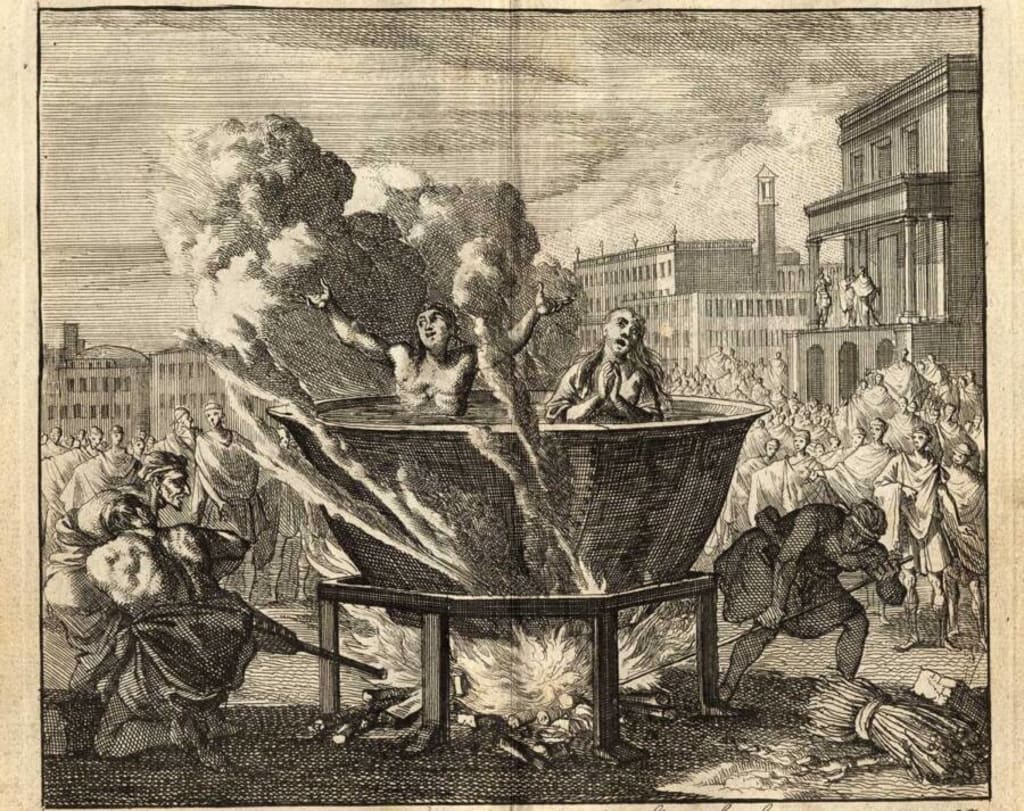Medieval Punishment
Boiling And Burning Alive

Burning, an agonizing method of execution, and boiling to death, equally brutal, were two of the worst forms of capital punishment that prevailed throughout various countries, particularly during the Middle Ages. To truly grasp the horrors of these methods, it's essential to delve into the history of their application.
Boiling to Death:
In the Middle Ages, boiling to death was not merely a horrifying method of execution, but it was also tragically slow. The victim would be immersed in boiling water, which would cause their skin, flesh, and fat to begin cooking progressively. The pain and shock from this ordeal were unimaginable, and it wasn't until their internal organs started cooking that they would finally succumb.
One haunting legend tells of William the Second, Lord of Hermitage Castle, who met this gruesome fate. William was a nobleman with a penchant for dabbling in dark arts and a reputation as a traitor who conspired against Scottish King Robert the Bruce. His cruel acts, including attaching his servants to yoke-like devices to perform grueling tasks, were attributed to the influence of his demonic familiar. The cruelty of his reign ultimately led to a local revolt, and in 1321, William was executed by being boiled, not in water but in molten lead.
A more plausible account of his death, accepted by historians, occurred in 1320, involving his conspiracy with the English against Robert the Bruce. The plot's failure led to William's imprisonment at Dumbarton Castle, where he eventually perished.
Another grisly case of boiling to death involved a cook in the household of the Bishop of Rochester. This cook had been found guilty of poisoning a soup meant for his master and guests, resulting in two fatalities. As punishment, he was subjected to public execution by boiling in Smithfield, London, in 1531. That same year, a maid's servant also faced the same gruesome fate for poisoning her mistress.
Boiling to death as a method of execution was not exclusive to any particular region. It was practiced across the Holy Roman Empire for various crimes, including forgery, fraud, and murder. In Britain, oil was occasionally favored over water for this method of execution. In Bremen, Germany, in 1687, a man faced boiling in oil for assisting coin forgers.
Burning:
During antiquity, the ancient Druids practiced human and animal sacrifice by burning. Large effigies, or "wicker men," were constructed from straw and wood, and these giant figures were set ablaze with people or animals inside them. By the Middle Ages, burning became a form of execution, and there were three primary methods:
Chained to the Stake: In this method, the prisoner would be fastened to a stake using chains or iron hoops. Bundles of wood would be piled around their feet. It was a visually intense and prolonged form of execution, favored by the Spanish Inquisition and the British. The slow progression of flames, causing the victim to endure a long and agonizing death, was thought to be fitting for heretics.
Surrounded by Wood: In this variation, the prisoner would be entirely encircled by bundles of wood, including up to the neck. This method, while inflicting a quick death due to smoke inhalation and suffocation, concealed the victim's suffering as flames raged around them.
Tied to a Ladder: A particularly horrific method popular in Germany and Scandinavia involved tying the prisoner to the top of a vertical ladder, which was then swung down and suspended over the fire. This caused a gradual "spit-roasting" effect before the victim caught fire.
Most cases of burning at the stake resulted in slow, painful deaths. Smoke inhalation was the only relief, causing victims to lose consciousness. In these excruciating deaths, the victims' bodies would contract, assuming a "pugilistic stance" as their flesh and internal organs burned. Complete destruction of a body would require an exceedingly hot fire, with temperatures in modern crematorium chambers reaching 800 to 1000 degrees Celsius.
One of the most well-known instances of burning at the stake was that of Joan of Arc, the Maid of Orleans. She was captured, tried as a heretic, and burned at the marketplace in Rouen, France, at just 19 years of age. Her execution by burning was the result of her heavenly visions and her crime of cross-dressing.
Burning was also a method of execution in the Holy Roman Empire, particularly for those found guilty of heresy. For heretics, the purifying flames were thought to cleanse their souls. By 1270, burning had become the primary form of punishment for heresy in the Holy Roman Empire.
In England, the date of the first burning is uncertain, but records indicate burnings as a method of execution were taking place by the early 13th century. Burning became a legal form of execution for heresy in England in the early 14th century.
While burning at the stake was a brutal and agonizing method of execution, it gradually waned in use. The last woman to be burned in Britain was executed in 1788, and the law was later repealed in 1790, changing the punishment to hanging for both men and women.
About the Creator
Ananymus Kelly
meticulous





Comments (1)
They had some brutal punishments back then! Great work!